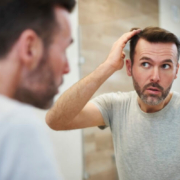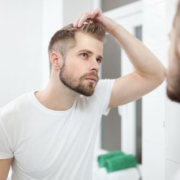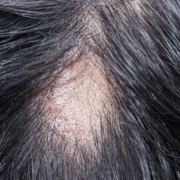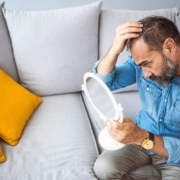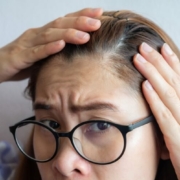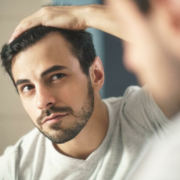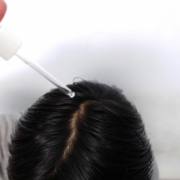What Is Topical Finasteride?
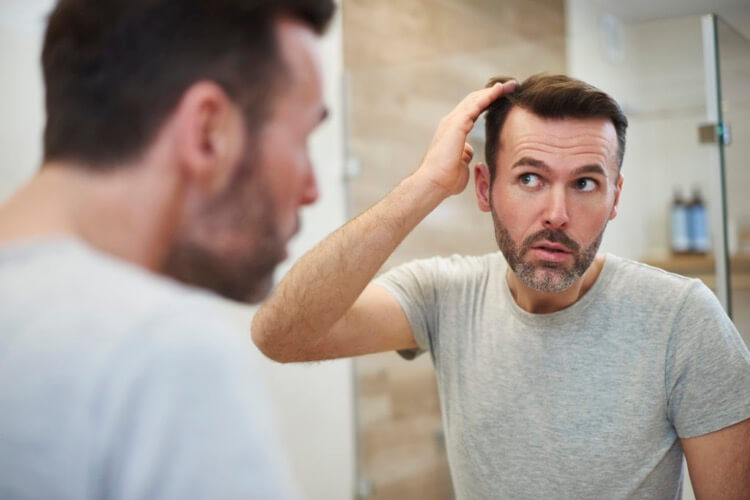
If you’re searching for hair loss treatments, finasteride is a name you’ll need to familiarize yourself with. Why? Only two hair loss products have received the FDA’s seal of approval — minoxidil is one of them. The other product is finasteride.
What is finasteride?
Although there are many different types of hair loss, the most common type is androgenetic or androgenic alopecia, also known as male pattern baldness or MPB. As part of a class of medications called 5-alpha reductase inhibitors, finasteride treats male pattern baldness by blocking testosterone’s ability to develop into dihydrotestosterone (DHT). DHT is a hormone that causes hair loss in adults, especially men. By blocking the production of DHT, finasteride reduces the amount of DHT within the scalp. (01)
Isn’t finasteride used for prostate issues?
Yes, finasteride is also prescribed for symptoms of benign prostatic hypertrophy (BPH) — an enlargement of the prostate gland. When used for BPH, finasteride reduces urinary frequency and urinary retention. However, the doses used in the treatment of BPH are much higher than the doses used to treat hair loss. As a treatment for BPH, finasteride is sold under the name Proscar.
What is finasteride’s history?
During finasteride’s use as an FDA-approved treatment for BPH under the name Proscar, researchers noticed its effectiveness against hair loss. Several years afterward, lower-dose finasteride was approved for hair loss under the name Propecia.
How does finasteride work against hair loss?
Finasteride works by inhibiting the action of the 5 alpha-reductase enzymes. Concentrated in the oil glands of hair follicles, 5 alpha-reductase, which helps convert testosterone into DHT, another hormone. For people who have the genes for hair loss, DHT binds to hair follicle receptors and diminishes the follicle’s size. If the follicle becomes too small, gradual hair loss occurs.
Finasteride inhibits 5 alpha-reductase, thus reducing serum DHT (the DHT in the blood). Without DHT to constrict hair follicles, hair loss slows and — for many people — hair regrows. With less DHT in the blood, some people see their hair loss stop completely. In short, finasteride protects hair follicles from DHT damage and stops hair loss.
Which Types of Hair Loss Does Finasteride Treat?
The average person loses 100 hairs each day, even with no hair loss issues. Hair falls away as part of each strand’s natural growth cycle, and the loss is negligible. Each strand of hair grows until its fullest length, then rests and eventually falls away. Afterwards, another strand grows to take its place. (02)
Excessive hair loss is more than a normal part of a hair’s growth cycle. Hair loss can become a problem when more than the average amount of hair is lost over time or if hair fails to regrow. For many people — about an estimated 80 million US adults — a balding scalp or thinning hair is the result of hereditary factors. (02)
If a person’s hair loss stems from DHT’s damage to hair follicles, then finasteride can help.
Is oral finasteride better than topical finasteride?
Finasteride requires a physician’s prescription. A physician can determine the cause of hair loss and prescribe the most appropriate treatment. Getting to the root of the problem determines what works and what doesn’t — like oral finasteride versus topical finasteride.
Oral finasteride, though effective, comes with a myriad of side effects. Many of the side effects of oral finasteride are life-altering, for example:
- Decreased sex drive
- Pain or tenderness in the testicles
- Numbness in the testicles
- A reduction in sperm count
- Difficulty obtaining or maintaining an erection (erectile dysfunction)
- Reduced ejaculatory volume
- Severe mood changes
- Breast enlargement
In rare cases, oral finasteride may cause permanent side effects.
Fortunately, taking finasteride topically reduces many of the more problematic side effects caused by taking finasteride orally. However, topical finasteride isn’t without precautions and still necessitates professional oversight to monitor and prevent side effects. Though not as severe as oral finasteride, some topical finasteride side-effects include:
- Decreased sex drive
- Inability to urinate
- Swelling of hands and feet
- Increased liver enzymes
- Headaches
- Testicular tenderness
- Scalp irritation
- Contact dermatitis
- Depression or anxiety
- Dizziness or weakness
Can you buy finasteride over the counter?
Because finasteride works best for people with an inherited tendency for hair loss, it’s safest to have a physician determine its use. Therefore, finasteride is not a product that anyone can purchase at a pharmacy without a prescription. Finasteride is not an over-the-counter medication and requires a physician’s approval.
Is topical finasteride effective for hair loss?
Topical finasteride works excellently against hair loss. What’s more, topical finasteride avoids many of the adverse side effects that may deter others from completing treatment. The following are studies highlighting the effectiveness of oral finasteride.
- A 2016 article published in the journal Dermatology Clinics and Research of 107 people found that:
- Both topical and oral finasteride are equally effective.
- However, participants on topical finasteride were more likely to complete treatment because there were less side effects. (03)
- A 2019 literature review published in the Journal of Drugs and Dermatology found that topical finasteride delivered: (04)
- A significant decrease in the rate of hair loss.
- An increase in hair counts.
- A reduction in DHT levels within the scalp and plasma.
- A 2021 study published in the Journal of European Academy of Dermatology and Venereology utilized 458 study participants found: (05)
- No serious adverse side effects in participants.
- Fewer complaints of sexual side effects when using topical finasteride.
- Topical finasteride improves overall hair count while producing fewer adverse side effects.
To summarize, the topical application of finasteride is as effective as taking the drug orally. However, adverse side effects are less common with the topical application of finasteride when compared to oral treatment.
When taken orally, finasteride goes through the digestive system and into the bloodstream. Applied as a topical, it bypasses the digestive tract and goes straight to its target with little to no side effects. This aspect makes topical use much more desirable, making users more likely to stick with the treatment!
How do you balance the effectiveness of finasteride versus the side effects?
Getting the most benefits from finasteride with minimal side effects is achieved through:
- Combining both finasteride and minoxidil, the two only FDA-approved medications for hair loss.
- Customizing hair loss treatment to the needs of each individual, making every formula unique to each person’s needs.
Because each person is different, it’s essential to make every finasteride treatment as specific to the person as possible. By catering the therapy to each person, adverse side effects are less likely to occur. And because side effects like the loss of libido and a reduction in sperm count can lead to non-adherence with treatment, catering each treatment to the patient makes it more likely that customers finish their treatment and see successful results.
Making That First Step Towards Finasteride Hair Treatments
Happy Head requires a physician assessment to begin treatment. Happy Head, in collaboration with the physician and the customer, determines the most effective hair loss treatment with the least amount of side effects. The involvement of a licensed professional helps to improve safety, provides valuable feedback, and determines the most successful path toward stopping hair loss.
With the help of board-certified dermatologists, you can find the right balance of finasteride treatments to suit your hair loss needs. Happy Head understands that hair loss can hurt. Losing your hair can be a traumatic event, even if it occurs slowly over time. Add the fact that hair loss treatments often come with side effects, and it can make anyone feel overwhelmed when searching for treatments. With Happy Head, help is just around the corner!
Resources:
(01) https://medlineplus.gov/druginfo/meds/a698016.html
(02) https://www.aad.org/media/stats-numbers
(03) https://www.scitcentral.com/article.php?journal=19&article=60&article_title=Randomized%20Comparative%20Research%20Study%20of%20Topical%20and%20Oral%20Finasteride%20with%20Minoxidil%20for%20Male%20Pattern%20Androgenetic%20Alopecia%20in%20Indian%20Patients
(04) https://www.ncbi.nlm.nih.gov/pmc/articles/PMC6609098/(05) https://pubmed.ncbi.nlm.nih.gov/34634163/

